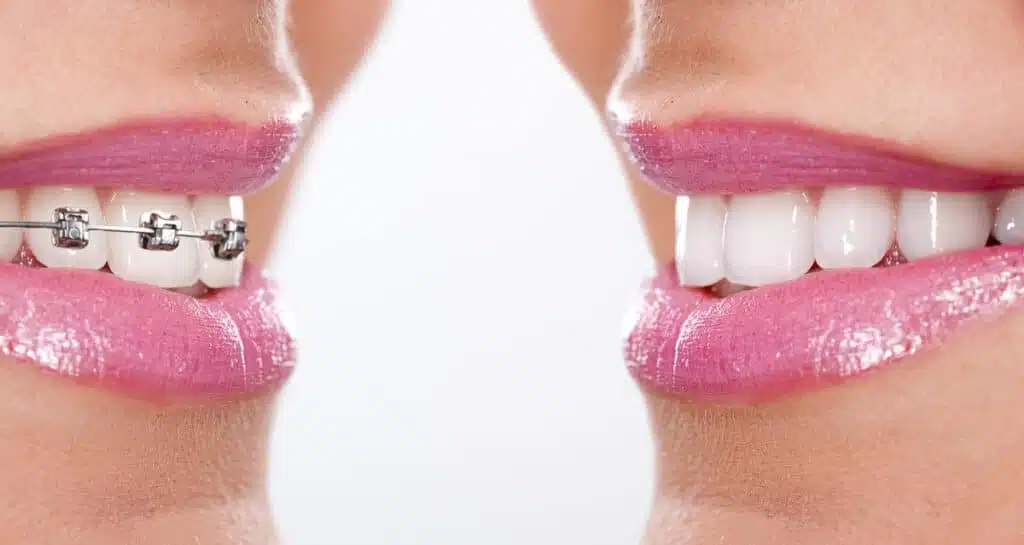How to floss with Braces – everything you need to know about the right Technique and suitable Alternatives like Water Flossers etc.
If you have braces, you know how important it is to maintain good oral hygiene.
While brushing is essential, flossing is crucial in keeping your teeth and gums healthy throughout your orthodontic treatment.
Flossing with braces can be challenging at first, but with the right technique and tools, it becomes easier and more effective.
In this article, we will guide you through flossing with braces, providing useful tips and insights to ensure optimal oral health.

Understanding Braces and Oral Health
Before we dive into the specifics of flossing with braces, it’s essential to understand the role of braces in oral health.
Braces are orthodontic appliances used to correct misaligned teeth and bite issues.
They consist of brackets, wires, and bands that apply gentle pressure, gradually moving the teeth into their desired positions.
While braces are excellent for achieving a beautiful smile, they can create additional spaces and areas that are harder to clean, making oral hygiene practices, like flossing, even more crucial.
Importance of Flossing with Braces
Flossing with braces is essential for several reasons. First, it helps remove food particles and plaque trapped between your teeth and braces.
If left unattended, these particles can lead to tooth decay, gum disease, and even white spots on your teeth after the braces are removed.
Additionally, flossing promotes healthy gums and prevents gingivitis, ensuring that gum issues do not compromise your orthodontic treatment.
Tools Needed for Flossing with Braces
To effectively floss with braces, you will need a few specialized tools. These include orthodontic floss threaders, dental or orthodontic floss, and interdental or proxy brushes.
Orthodontic floss threaders help you navigate the floss around the wires and brackets, while interdental brushes clean the spaces between the teeth and under the wires.
Investing in these tools is essential to make flossing with braces more efficient and convenient.
Step-by-Step Guide: How to Floss with Braces
Flossing with braces may initially seem challenging, but following a step-by-step guide can help simplify the process. Here’s how to floss with braces effectively:
- Start by threading the orthodontic floss through the loop of the floss threader.
- Carefully insert the floss threader under the wire of your braces and pull the floss through.
- Gently slide the floss up and down between two teeth, forming a C-shape around each tooth.
- Move the floss up and down to clean the sides of both teeth.
- Repeat this process for all the teeth, using a clean section of floss for each gap.
- Use interdental or proxy brushes to clean between the teeth and around the wires for hard-to-reach areas.
- Rinse your mouth thoroughly with water or an antiseptic mouthwash to remove loosened debris.
- Remember to floss at least once daily, preferably before bedtime, to maintain optimal oral health.

Tips for Effective Flossing with Braces
To ensure effective flossing with braces, consider the following tips:
- Take your time: Flossing with braces requires patience and attention to detail. Allocate enough time in your oral care routine to thoroughly clean all the spaces.
- Be gentle: While it’s important to clean thoroughly, avoid applying excessive force that could damage your braces or wires.
- Use the right technique: Position the floss properly around each tooth, ensuring it reaches under the gum line. This helps remove plaque and debris effectively.
- Maintain consistency: Make flossing a daily habit, even after removing your braces. Regular flossing will help you maintain good oral health in the long run.
Common Mistakes to Avoid
When flossing with braces, it’s crucial to avoid common mistakes that can compromise your oral health.
Some of these mistakes include:
- Using a sawing motion: Instead of sawing back and forth, move the floss up and down along the sides of each tooth for better cleaning.
- Skipping flossing: With braces, it’s easy to overlook flossing due to the added effort. However, skipping flossing can lead to dental issues, so prioritize it.
- Neglecting the gum line: Plaque and bacteria can accumulate near the gum line, leading to gum problems. Ensure you floss below the gum line to maintain healthy gums.
Alternatives to Traditional Flossing
If traditional flossing with braces proves challenging, there are alternative methods you can explore:
- Water flossers: Water flossers use a stream of water to remove plaque and debris from between the teeth and braces. They can be a convenient and effective alternative to traditional flossing.
- Interdental brushes: These small brushes can clean the spaces between the teeth and around the wires, efficiently removing food particles and plaque.
Maintaining a Healthy Oral Care Routine
Apart from flossing, it’s important to maintain a comprehensive oral care routine while wearing braces. This includes:
- Brushing your teeth thoroughly at least twice daily, using a soft-bristled toothbrush and fluoride toothpaste.
- Using an antimicrobial mouthwash to kill bacteria and freshen your breath.
- Follow any additional instructions your orthodontist provides, such as using special mouth rinses or fluoride treatments.
When to Seek Professional Help
While regular flossing and oral care practices are usually sufficient, there may be instances where you need professional assistance.
If you experience severe pain, bleeding gums, or any other concerning symptoms, you must reach out to your orthodontist or dentist for a thorough evaluation.
Conclusion on the Topic: “How to Floss with Braces”
Flossing with braces is crucial to maintaining good oral health during orthodontic treatment.
By following the step-by-step guide, using the right tools, and adopting proper techniques, you can effectively remove plaque and food particles, preventing dental issues.
Remember to be consistent, gentle, and patient while flossing. Prioritize your oral care routine, and seek professional help if needed. With diligent flossing, you can achieve a healthy and beautiful smile.

FAQs on the Topic: “How to floss with Braces.”
Can I use regular dental floss with braces?
Regular dental floss may be challenging to navigate around the wires and brackets. Orthodontic floss or floss threaders are designed explicitly for flossing with braces and provide better results.
How often should I floss with braces?
It is recommended to floss at least once a day, preferably before bedtime, to maintain good oral hygiene and prevent dental issues.
Can I use a water flosser instead of traditional floss with braces?
Yes, water flossers can be an effective alternative to traditional flossing. However, consult your orthodontist for specific recommendations and guidance.
What should I do if I find it difficult to floss with braces?
If you struggle with flossing, consult your orthodontist or dentist. They can provide additional tips, recommend alternative methods, or adjust your braces to facilitate easier flossing.
Will flossing with braces take longer than usual?
Flossing with braces may take a bit longer initially as you become accustomed to the process. However, with practice, it will become quicker and more efficient.
- About the Author
- More info


Leave a Reply